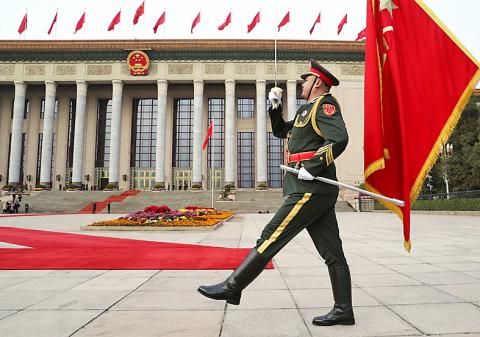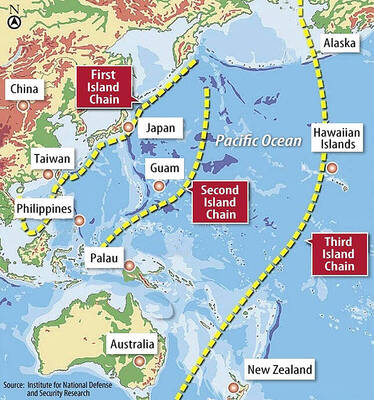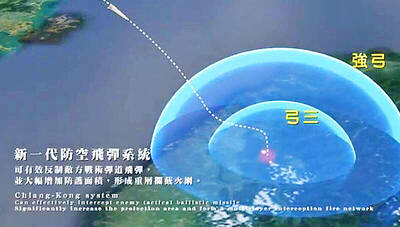The Pentagon on Tuesday released a report that lays out US concerns about China’s growing military might, underscoring worries about a possible attack on Taiwan.
The key concern is that as China upgrades its military equipment and technology, and reforms how it trains and develops troops, it becomes more confident in its ability to wage a regional conflict, a senior US defense intelligence official told reporters.
Beijing has made it clear that asserting sovereignty over Taiwan is its top priority, they said.

Photo: AP
Although China could easily fire missiles at Taiwan, it does not yet have the military capability to successfully invade, the official added.
They spoke on condition of anonymity to provide more detail on intelligence findings in the report, which was written by the US Defense Intelligence Agency.
Its release came a week after Chinese President Xi Jinping (習近平) called on the Chinese People’s Liberation Army (PLA) to better prepare for combat.
The report talks broadly about the steps China is taking to modernize its military and expand its operations around the globe.
The worry is that China would reach the point where leaders would decide that using military force for a regional conflict is more imminent, the official said.
“Beijing’s long-standing interest to eventually compel Taiwan’s reunification with the mainland and deter any attempt by Taiwan to declare independence has served as the primary driver for China’s military modernization,” the report says. “Beijing’s anticipation that foreign forces would intervene in a Taiwan scenario led the PLA to develop a range of systems to deter and deny foreign regional force projection.”
The PLA is “likely to grow even more technologically advanced, with equipment comparable to that of other modern militaries,” it said.
The US official said that China has been working hard on developing ways to combine cyberattacking capabilities with kinetic weapons.
However, Beijing would face a significant challenge as it tries to bring generational change to its military, they added.
China has mainly done tightly controlled regional operations and some counterpiracy missions, but it would be more difficult to create a joint force capable of conducting large, complex combat operations far abroad, the official said.
Ministry of National Defense Major General Chen Chung-chi (陳中吉) said that Taiwan watches the development of Chinese military capabilities more closely than any other nation.
“However warfare could play out, that is how we train,” Chen said on the sidelines of a simulated drill at the Hsinchu Air Base to reinforce the military’s defense capabilities ahead of the Lunar New Year holiday.
Additional reporting by Aaron Tu

LIMITS: While China increases military pressure on Taiwan and expands its use of cognitive warfare, it is unwilling to target tech supply chains, the report said US and Taiwan military officials have warned that the Chinese People’s Liberation Army (PLA) could implement a blockade within “a matter of hours” and need only “minimal conversion time” prior to an attack on Taiwan, a report released on Tuesday by the US Senate’s China Economic and Security Review Commission said. “While there is no indication that China is planning an imminent attack, the United States and its allies and partners can no longer assume that a Taiwan contingency is a distant possibility for which they would have ample time to prepare,” it said. The commission made the comments in its annual

DETERMINATION: Beijing’s actions toward Tokyo have drawn international attention, but would likely bolster regional coordination and defense networks, the report said Japanese Prime Minister Sanae Takaichi’s administration is likely to prioritize security reforms and deterrence in the face of recent “hybrid” threats from China, the National Security Bureau (NSB) said. The bureau made the assessment in a written report to the Legislative Yuan ahead of an oral report and questions-and-answers session at the legislature’s Foreign Affairs and National Defense Committee tomorrow. The key points of Japan’s security reforms would be to reinforce security cooperation with the US, including enhancing defense deployment in the first island chain, pushing forward the integrated command and operations of the Japan Self-Defense Forces and US Forces Japan, as

INTERCEPTION: The 30km test ceiling shows that the CSIST is capable of producing missiles that could stop inbound missiles as they re-enter the atmosphere Recent missile tests by the Chungshan Institute of Science and Technology (CSIST) show that Taiwan’s missiles are capable of intercepting ballistic missiles as they re-enter the atmosphere and pose a significant deterrent to Chinese missile threats, former Hsiung Feng III missile development project chief engineer Chang Cheng (張誠) said yesterday. The military-affiliated institute has been conducting missile tests, believed to be related to Project Chiang Kung (強弓) at Pingtung County’s Jiupeng Military Base, with many tests deviating from past practices of setting restriction zones at “unlimited” and instead clearly stating a 30.48km range, Chang said. “Unlimited” restrictions zones for missile tests is

NO CHANGES: A Japanese spokesperson said that Tokyo remains consistent and open for dialogue, while Beijing has canceled diplomatic engagements A Japanese official blasted China’s claims that Japanese Prime Minister Sanae Takaichi has altered Japan’s position on a Taiwan crisis as “entirely baseless,” calling for more dialogue to stop ties between Asia’s top economies from spiraling. China vowed to take resolute self-defense against Japan if it “dared to intervene militarily in the Taiwan Strait” in a letter delivered Friday to the UN. “I’m aware of this letter,” said Maki Kobayashi, a senior Japanese government spokeswoman. “The claim our country has altered its position is entirely baseless,” she said on the sidelines of the G20 summit in Johannesburg on Saturday. The Chinese Ministry